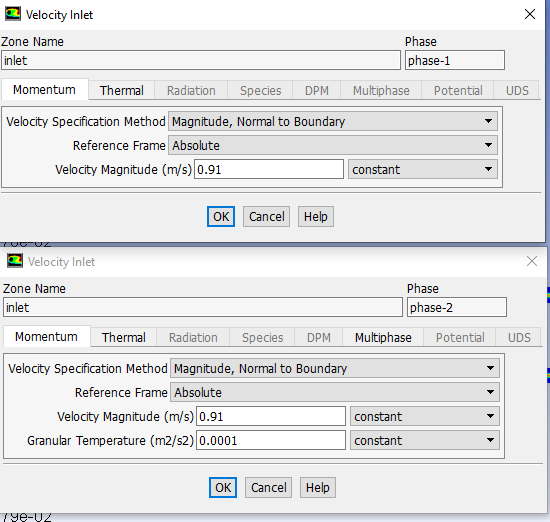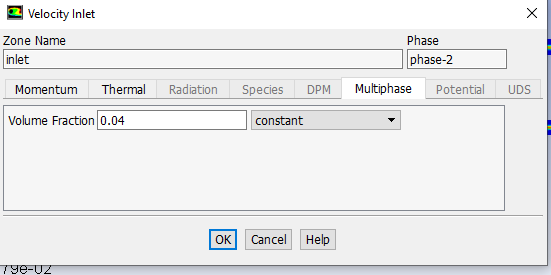-
-
January 13, 2021 at 1:34 pm
Abdelrahman92
SubscriberHi nI am simulating fluid-granular flow using Eulerian model. nI want to ask about the B.C at the inlet for the two phases:nThe primary phase (fluid) has a defined velocity inlet, and the secondary phase has constant concentration (or volume fraction at the inlet, let say 4% (0.04)). nI used to specify the inlet fluid velocity and particle volume fraction while keeping particle inlet velocity at zero (because I thought that fluent will automatically calculate the particle velocity based on the volume fraction and the mass flowrate of the inlet fluid). However, i figured that this could be not correct and maybe the reason why I did not get reasonable results. nMy question: Shall I specify the particle inlet velocity as the same as the fluid velocity or i need to calculate the actual velocity of particle phase (as mentioned earlier based on Vf and Vf) and then use that velocity as inlet condition.Thanks in advance n -
January 14, 2021 at 10:02 am
Abdelrahman92
SubscriberYour help is appreciated !n -
January 14, 2021 at 10:58 am
Rob
Forum ModeratorJust add the second phase at the same velocity and set the volume fraction to whatever you want it to be. If you set zero velocity the second phase won't enter the domain as there is no associated mass flow. n -
January 19, 2021 at 10:22 am
Abdelrahman92
SubscriberThanks for your response Rob. However, I was wondering when I add the second phase at the same velocity of the primary phase, that means I am specifying similar volumetric flowrate (m3/s) for both phases (since they enter through a constant cross section area at the inlet). In that case, the volume concentration will be fixed at 0.5 for each phase. Please correct me if I am wrong. n -
January 19, 2021 at 10:31 am
Amine Ben Hadj Ali
Ansys EmployeeNo you are providing the true velocity here. What you are talking about is the volumetric flux which will then correspond to superficial velocity: the velocity of the phase if to flow alone in the pipe.nn -
January 19, 2021 at 11:00 am
Abdelrahman92
SubscriberThanks for the clarifications. Then I will use the same velocity values for both phases and see what else I am missing in this simulation. n -
January 19, 2021 at 11:38 am
Amine Ben Hadj Ali
Ansys EmployeeJeppn -
January 19, 2021 at 2:04 pm
Abdelrahman92
SubscriberHello AgainnI just revised the case when I used similar velocities the the two phases, and I found that the volume flowrate (m3/s) at the inlet for the two phases is equal. I obtained these value from Report-surface integral- volume flowrate. If the inlet flowrate of the solid phase is equal to that of the liquid, how can the volume concentration be 0.04. I am confused?Thanks n -
January 20, 2021 at 12:08 pm
Rob
Forum ModeratorThe velocity tells the solver how fast the material is being added to the model. The volume fraction is how much of it is added. Can you post screen shots of the boundary condition panel and the volume fraction & velocity contours in that area? n -
January 20, 2021 at 2:03 pm
-
January 20, 2021 at 2:04 pm
-
January 20, 2021 at 2:14 pm
-
January 20, 2021 at 2:14 pm
-
January 20, 2021 at 2:36 pm
Rob
Forum ModeratorVolume fraction looks right. If you check the mass flux how does it look? n -
January 21, 2021 at 6:54 am
Abdelrahman92
SubscriberMass flux looks ok. if you see the attached pictures, you will find mass of mixture is 0.785 kg/s, and that for the particle phase 0.075. When I translate theses value into volumetric flowrate, if found that mixture and particles have flowrates of 7.8e-3 and 2.96e-5 m3/s, which equals a volume fraction of 0.0376. However, I still don't understand why I got similar volume flowrate from surface integral report as shown in the above picturen
 n
n
-
January 21, 2021 at 7:40 am
Abdelrahman92
SubscriberOne thing I was thinking about. If I specify the inlet v of particle at 0 but the volume fraction is 0.04, there will be no inlet mass flow of particles So what is the point of the volume fraction here. Does that mean the inlet initially has particles (with vf 0.04) but without extra particles coming into the domain ?n -
January 21, 2021 at 7:59 am
Amine Ben Hadj Ali
Ansys EmployeeVolumetric Rate is just velocity time area. So all is correct.nVolume fraction is telling the solver how much of the phase is coming into the domain. If you still do not feel comfortable with all just use mass flow boundary condition and play a bit in a dummy case so that you understand the correlation between all inputsn
-
Viewing 16 reply threads
- The topic ‘Boundary condition for E-E multiphase model’ is closed to new replies.
Innovation Space


Trending discussions


Top Contributors


-
4678
-
1565
-
1386
-
1242
-
1021
Top Rated Tags


© 2025 Copyright ANSYS, Inc. All rights reserved.
Ansys does not support the usage of unauthorized Ansys software. Please visit www.ansys.com to obtain an official distribution.













